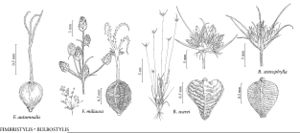Fimbristylis miliacea
Enum. Pl. 2: 287. 1805.
Plants annual, cespitose, 15–50(–70) cm, glabrous, base soft; rhizomes absent. Leaves distichous, in fans, to ca. 2/3 plant height; sheaths keeled, equitant, margins entire; ligule absent; blades bifacial (flattened in same plane as sheath), narrowly triangularlinear, to 2 mm wide, margins scabrid at least distally. Inflorescences: anthela compound, usually diffuse, branched, broadening upward, often as broad as long; scapes slender, angularly ribbed and/or somewhat compressed distally, 1–1.5 mm wide or thick; involucral bracts exceeded by anthela. Spikelets dark red-brown, broadly ovoid to near round, 2–4 min; fertile scales broadly ovate to orbiculate, 1 mm, glabrous, apex broadly rounded, midrib not excurrent. Flowers: stamens 1–2; styles 3-fid, slender, base dilated, apex pubescent. Achenes pale brown, tumid, obovoid, 1 mm, apiculate, reticulate, with pits narrowly rectangular in 4–6 vertical rows per side, the longitudinal ribs most prominent and mostly warty. 2n = 10.
Phenology: Fruiting summer–fall, all year southward.
Habitat: Moist to wet sands and alluvia of open river and stream bottoms, low fields, drawdowns, shores, flatwoods, savanna, seeps, and open disturbed waste places
Elevation: 0–200 m
Distribution

Introduced; Ala., Ark., Fla., Ga., Ky., La., Miss., Mo., N.C., S.C., Tenn., Tex., Mexico, Central America, South America, Asia, Africa, Indian Ocean Islands, Pacific Ocean Islands, Australia.
Discussion
Fimbristylis miliacea is another widespread annual weed whose origin is probably in the Asian rice belt. Two Linnaean types bear the epithet “miliacea.” A good argument exists that Vahl, first to adopt the plant as a Fimbristylis, took the round-spikeleted element as F. miliacea; the other, ovoid, acute-spikeleted element thus became F. quinquangularis (Vahl) Kunth.
Because Gaudichaud’s epithet “littoralis” was not applied to the complex until 1826, it is invalidated in any case.
Selected References
None.
